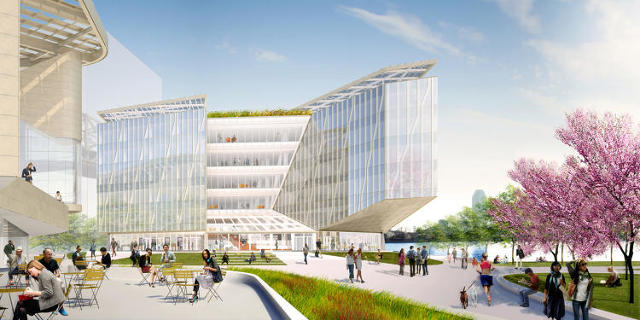At New York City’s newest university, the Ivory Tower is being declared dead before it even gets built.
That’s the philosophy embodied in the name the Bridge, one of three buildings slated to open in 2017 during the first phase of construction of Cornell Tech’s new $2 billion, 12-acre campus on Roosevelt Island. The graduate school—a pillar of New York City’s efforts to grow its tech economy—is not shy about its desire to knock down traditional barriers between academia and industry collaboration. The Bridge, formerly referred to as the “corporate co-location” building, is where the action will happen.
“It’s taking this notion of the commercialization of academia to a higher plane,” says MaryAnne Gilmartin, CEO of Forest City Ratner Companies, the owner and developer of the building. She revealed the name exclusively to Co.Exist before a groundbreaking ceremony on June 16 (see a promo video here). Cornell Tech will lease about one-third of the seven-story building, while a co-working space and a mix of startups and larger companies will occupy much of the rest of 200,000 square-feet.

Stanford University is probably the school best known for working closely with the tech economy it helped create. For better, or some say for worse, the walls between Silicon Valley and the school are fluid today. Cornell Tech is looking for similar deep connections with industry, but it knows it needs to go about it more deliberately.
“We’re trying to build a different type of tech ecosystem in a different city with a different character,” says Greg Pass, Cornell Tech’s Chief Entrepreneurial Officer and the former CTO of Twitter. “Stanford is really sitting adjacent to industry—it’s more natural and organic, the collaborations there. New York is a much bigger city, and it’s a much more diverse city. There’s so much more going on, which is wonderful, but it also requires a bit more design to make the collaboration happen. It can’t be as organic.”

The Bridge is unusual for New York office space in that it doesn’t have pre-leased anchor tenants other than Cornell Tech. The companies in the building will be carefully curated by Forest City Ratner, in discussions with the university. The goal is to bring in an eclectic mix of startups (ideally involving the school’s graduates) and larger companies working on applications that match Cornell’s program areas: connective media, the built environment, and health tech. However, established companies won’t be an ideal fit unless they bring in an R&D unit or entrepreneurial project detached from headquarters, says Gilmartin. Nor will leases generally last more than a few years, so there can be a constantly rotating mix of ideas. Right now, the team has a list of first-choice tenants it’s courting.
“Much about academia is rooted in the industrial age,” says Pass. “We’re about reinventing academia for digital age.”
The design of the open, loft-like glass building, which will sit alongside an academic building and residential building, is meant to facilitate interactions between and among students and companies. Designed by architects Marion Weiss and Michael Manfredi, it will contain indoor and outdoor shared spaces for conversations, gatherings, and events. At the campus level, there will be a glass central atrium that opens to the campus and offers stunning views of Manhattan and Queens. Though there will be private spaces for companies with intellectual property needs, anyone will be able to walk by a studio space in the building and see what’s being built in inside. “That kind of transparency is not common for a building—to be able to walk around and get a sense of its production,” says Pass.
Today, Cornell Tech, which is actually a partnership between Cornell University and Israel’s Technion university, is already up and running at a much small scale, using space inside Google’s Chelsea headquarters. An emphasis on real-world applications runs through everything the program does, from its unorthodox hiring criteria for faculty to its requirement that students design products or businesses to graduate, advised by mentors who from the tech or business world. Five spin-out companies came from the most recent graduating class, says Pass. So far, almost 100 students have graduated in the first two years of the program.

For the city, which launched the campus by awarding the prime real estate and putting in $100 million, there is a bet that Cornell Tech can help the innovation economy flourish and create more companies rooted in New York. While the city’s tech and startup clout has grown a lot over the years, it’s yet to birth many major companies like Google or Facebook. In a first-of-its-kind collaboration, the U.S. Department of Commerce even plans to station a U.S. patent officer there.
Gilmartin believes that the building itself is a model for a new type of office building that fosters collaboration among tenants.
“Individual companies have done it in their space—you see places that have been designed for high performance, high connectivity, and high creativity. But I think the idea that it’s happening beyond the boundaries of a particular company [or university] is interesting,” she says. “Our job is not to hyper manage it, but to allow it to become whatever it wants to become.”
[All images credited to architects Weiss/Manfredi.]
The U.S. Department of Commerce doesn’t plan to open a patent office at Cornell Tech, but it does plan to station a patent officer. This article was corrected.